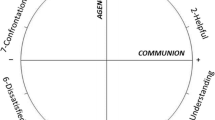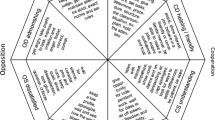Abstract
The model for interpersonal teacher behavior, mapping the various teachers’ interpersonal behaviors, has been applied for research in many countries. In order to measure the students’ perceptions regarding the interaction with their teachers, the Questionnaire on Teacher Interaction (QTI) has been developed. The QTI has been shown to be a valid and reliable instrument in all the different language versions in which it was adapted. Translated and validated in many countries, the QTI has not yet received a validation in Italy. The present study was conducted on a population of Italian secondary school students with the aim to examine the psychometric properties of the Italian translation of the QTI in its 64-item version. Results show that individual and class-mean reliabilities and the values related to the scales’ ability to differentiate between classrooms are in line with those of the original research and of the other validation studies. Moreover, the circumplex nature of the octagonal model of the QTI is confirmed by the interscale correlations. Finally, results show that the more positive are the QTI dimensions of affiliation and control, the more positive are students’ academic achievement and learning motivation.

Similar content being viewed by others
Notes
The Italian version could be provide by request.
References
Berliner, D. C., & Calfee, R. C. (Eds.). (1996). Handbook of educational psychology. New York, NY: Pergamon.
Berti, C., Molinari, L., & Speltini, G. (2010). Classroom justice and psychological engagement: Students’ and teachers’ representations. Social Psychology of Education, 13, 541–556.
Borg, I., & Groenen, P. J. F. (1997). Modern multidimensional scaling: Theory and applications. New York: Springer.
Brekelmans, M., Wubbels, Th, & den Brok, P. (2002). Teacher experience and the teacher–student relationship in the classroom environment. In S. C. Goh & M. S. Khine (Eds.), Studies in educational learning environments: An international perspective (pp. 73–100). Singapore: New World Scientific.
Chiew Goh, S., & Fraser, B. J. (1998). Teacher interpersonal behaviour, classroom environment and student outcomes in primary mathematics in Singapore. Learning Environments Research, 1, 199–229.
Croninger, R. G., & Lee, V. E. (2001). Social capital and dropping out of high school: Benefits to at-risk students of teachers’ support and guidance. Teachers College Record, 103, 548–581.
den Brok, P., Brekelmans, M., & Wubbels, T. (2006a). Multilevel issues in research using students’ perceptions of learning environments: The case of the Questionnaire on Teacher Interaction. Learning Environments Research, 9, 199–213.
den Brok, P., Fisher, D., Brekelmans, M., Wubbels, T., & Rickards, T. (2006b). Secondary teachers’ interpersonal behaviour in Singapore, Brunei and Australia: A cross-national comparison. Asia-Pacific Journal of Education, 26, 79–95.
den Brok, P., van Tartwijk, J., Wubbels, T., & Veldman, I. (2010). The differential effect of the teacher–student interpersonal relationship on student outcomes for students with different ethnic backgrounds. The British Journal of Educational Psychology, 80, 199–221.
Fisher, D. L., Fraser, B. J. & Rickards, T. (1997). Gender and cultural differences in teacher–student interpersonal behavior. Paper presented at the annual meeting of the American Educational Research Association, Chicago, IL.
Kim, H.-B., Fisher, D. L., & Fraser, B. J. (2000). Classroom environment and teacher interpersonal behaviour in secondary science classes in Korea. Evaluation & Research in Education, 14, 3–22.
Kokkinos, C. M., Charalambous, K., & Davazoglou, A. (2009). Interpersonal teacher behaviour in primary school classrooms: A cross-cultural validation of a Greek translation of the Questionnaire on Teacher Interaction. Learning Environments Research, 12, 101–114.
Koul, R., & Fisher, D. (2005). Cultural background and students’ perceptions of science classroom learning environment and teacher interpersonal behaviour in Jammu, India. Learning Environments Research, 8, 195–211.
Kremer-Hayon, L., & Wubbels, T. (1993). Supervisors’ interpersonal behavior and student teachers’ satisfaction. In T. Wubbels & J. Levy (Eds.), Do you know what you look like? (pp. 123–135). London: Falmer Press.
Kyriakides, L. (2005). Drawing from teacher effectiveness research and research into teacher interpersonal behaviour to establish a teacher evaluation system: A study on the use of student ratings to evaluate teacher behaviour. Journal of Classroom Interaction, 40, 44–66.
Lapointe, J. M., & Legault, F. (1999). Version francophone du Questionnaire for Teacher Interaction en context québécois [French version of the Questionnaire for Teacher Interaction in the Quebec context]. Mesure et évaluation en éducation, 22, 1–20.
Leary, T. (1957). An interpersonal diagnosis of personality. New York: Ronald Press Company.
Mainhard, T., Wubbels, T., & Brekelmans, M. (2013). The role of the degree of acquaintance with teachers on students’ interpersonal perceptions of their teacher. Social Psychology of Education, 17, 127–140.
Maulana, R., Opdenakker, M.-C., den Brok, P., & Bosker, R. (2011). Teacher–student interpersonal relationships in Indonesia: Profiles and importance to student motivation. Asia Pacific Journal of Education, 1, 33–49.
Rickards, T., & Fisher, D. (1999). Teacher–student classroom interactions among science students of different sex and cultural background. Research in Science Education, 29, 445–455.
Ryan, A. M., & Patrick, H. (2001). The classroom social environment and changes in adolescents’ motivation and engagement during middle school. American Educational Research Journal, 38, 437–460.
Scott, R. H., & Fisher, D. L. (2004). Development, validation and application of a Malay translation of an elementary version of the Questionnaire on Teacher Interaction. Research in Science Education, 34, 173–194.
Telli, S., den Brok, P., & Cakiroglu, J. (2007). Students’ perceptions of science teachers’ interpersonal behaviour in secondary schools: Development of a Turkish version of the Questionnaire on Teacher Interaction. Learning Environments Research, 10, 115–129.
Watzlawick, P., Beavin, J. H., & Jackson, D. (1967). The pragmatics of human communication. New York: Norton.
Wiggins, J. S., Phillips, N., & Trapnell, P. (1989). Circular reasoning about interpersonal behavior: Evidence concerning some untested assumptions underlying diagnostic classification. Journal of Personality and Social Psychology, 56, 296–305.
Wubbels, T., & Brekelmans, M. (1997). A comparison of student perceptions of Dutch Physics teachers’ interpersonal behavior and their educational opinions in 1984 and 1993. Journal of Research in Science Teaching, 34, 447–466.
Wubbels, T., & Brekelmans, M. (2005). Two decades of research on teacher–student relationships in class. International Journal of Educational Research, 43, 6–24.
Wubbels, T., Brekelmans, M., den Brok, P., Levy, J., Mainhard, T., & van Tartwijk, J. (2012). Let’s make things better. In P. J. den Brok, J. van Tartwijk, J. Levy, & T. Wubbels (Eds.), Interpersonal relationships in education: An overview of contemporary research (pp. 225–249). Rotterdam: Sense Publishers.
Wubbels, T., Brekelmans, M., den Brok, P., Veldman, I., & van Tartwijk, J. (2006). Teacher interpersonal competence for Dutch multicultural classrooms. Teachers and Teaching: Theory and Practice, 12, 407–433.
Wubbels, T., Brekelmans, M., & Hermans, J. (1987). Teacher behavior: An important aspect of the learning environment? The Study of Learning Environments, 3, 10–25.
Wubbels, T., Brekelmans, M., & Hooymayers, H. P. (1992). Do teacher ideals distort the self-reports of their interpersonal behavior? Teaching and Teacher Education, 8, 47–58.
Wubbels, T., & Levy, J. (1991). A comparison of interpersonal behaviour of Dutch and American teachers. International Journal of Intercultural Relations, 15, 1–18.
Wubbels, T., & Levy, J. (1993). Do you know what you look like?. London: Falmer Press.
Author information
Authors and Affiliations
Corresponding author
Rights and permissions
About this article
Cite this article
Passini, S., Molinari, L. & Speltini, G. A validation of the Questionnaire on Teacher Interaction in Italian secondary school students: the effect of positive relations on motivation and academic achievement. Soc Psychol Educ 18, 547–559 (2015). https://doi.org/10.1007/s11218-015-9300-3
Received:
Accepted:
Published:
Issue Date:
DOI: https://doi.org/10.1007/s11218-015-9300-3




